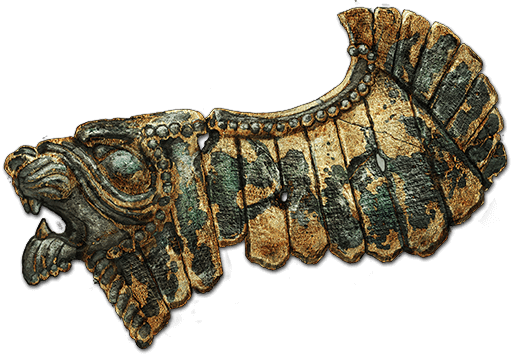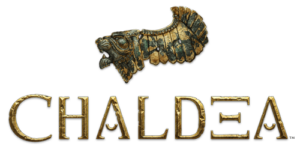A K K A D I A
Akkadia is one of the larger continents of Chaldea. It is an island-continent, like Perrin or Ata-Aimilleuse, and can only be reached from other lands by navigating The Great Sea. Akkadia is also the name of the empire that rules this continent and the people who are citizens of this empire are known as Akkadians. The Akkadian empire is composed of several kingdoms, the most prominent of which is Babil, which dominates the central, wealthiest region of Akkadia. The dominant ethnic group of Akkadia is the Anum people.
History of Akkadia
At the close of the Claw Hammer War there was a significant military force of Anum charioteers, spear, and slingers deployed near the present-day religious settlement of Galzu. During the two centuries following the war, during the Great Diaspora, this force emerged as the dominant belligerent power in the region and settled the lush farmlands of the Purattu and Idiqlat rivers. As word spread of the success of the Anum settlements here other pockets of Anum peoples scattered around Chaldea made their way here also. Eventually, this group gained enough strength and power to achieve statehood and founded the kingdom of Babil.
It didn't take long for Babil to start tackling its neighbors. By around Year -650, about 350 years after the Claw-Hammer War, the Anum people drove out most non-Anum ethnic strongholds and for about a hundred years ruled the continent they named New Akkadia. Eventually, the "New" was dropped and the continent, and the Babil empire, was simply called "Akkadia". This period is known as the first golden age of Akkadia.
But old prejudices die hard and the kings of Babil always saw the other lands of Akkadia as conquests and the people as foreign subjects, in spite of generally sharing the same ethnic makeup. This created resentments across Akkadia against their Babil overlords. By around year -575 this first empire of Akkadia collapsed from a series of uprisings around the continent. These uprisings would lead to the formation of new kingdoms, like Martu, Subartu, Uruk, Elam, and others.
During this period, in Year -525, Nabad, a mighty Kaldi king of Uruk, conquered Babil and established a dynasty that ruled the combined kingdoms of Babil and Uruk for four generations. Then in Year -485 an army of religious warriors from Sumer "liberated" Eriku and re-established the prior royal line of Babil, which immediately broke from their former masters of Uruk. But Babil was able to do little more than re-establish its original borders---it would take nearly two hundred years before the Akkadian empire would rise once more to rule the entire continent.
In Year -293, one of the greatest kings of Akkadian history, Patesi Amel-Marduk, came to power. Amel-Marduk reconquered all of Akkadia and usured in the second gold age of Akkadia. Amel-Marduk's reign is recognized as one of the greatest, most legendary reigns of any Chaldean in history, with tremendous advances in architecture, science, astrology, sorcery, navigation, and education. It was during Amel-Marduk's reign that Nabu Pabu wrote his famous catalog of anumian spirits.
Amel-Marduk died in Year -217. It only took four years before disaster struck. In Year -213, the Perts invaded Akkadia and colonized large portions of it. The Perts superior naval power gave them tremendous striking power into the coastal lands of Akkadia. But Akkadia's power lay in the center of the continent, in historical Babil, in the capital of Eriku. Against all odds, a Pert army landed in the Gida Hills of Uruk, bypassed the Swamp of Ases, and marched on Eriku, conquering it in Year -197.
Conquering Eriku was hard, but holding it turned out to be impossible. The dramatic setback of Akkadian fortune paved the way for a radical group of religious zealots to take control of the Akkadian government in exile in Sumer--and take over the religious aristocracy as well. These priestesses worshipped the Anum goddess Ishtar and few could foresee the impact they would have on Akkadia.
With divine providence on their side, Ishi-lana, high priestess of Ishtar, declared a holy war on the Perts and drove them out of Eriku, then Babil, then Uruk, and then the rest of Akkadia. In the wake of this reconquest of Akkadia, Ishi-lana led a cultural revolution, blaming men for the woes of Akkadia, swearing that from henceforth, Akkadia would be ruled by women. Thus came the third golden age of Akkadia.
The Akkadian empire established by Ishi-lana persevered through a line of female descendant patesi's. In the first year of Kordaava's reign, his legions sacked Eriku to prove Kordaava's dominance. But Kordaava took a light touch and appointed a descendant of Ishi-lana to continue ruling Akkadia as a vassal state.
In Year 24 of Kordaava's reign, Iltani, a daughter and demigoddess of Ishtar, arrived on the scene and slew Ahatsunu, the then-ruler of Akkadia and descendant of Ishi-lana, and claimed the throne of Akkadia for herself. With her power as a deity, Ishtar's blessing, and Kordaava's blessing, no one dared oppose her.
Patesi Iltani has ruled Akkadia ever since.
Anum People
The Anum people are an ethnic group that traces their roots back to a force of military units and civilian support personnel from another plane, called Old Akkadia, during the Claw-Hammer War.
As is typical of the era following the Claw-Hammer War, during the Great Disapora, most groups of Anum stationed in other regions of Chaldea who were not able to reach Babil were mostly destroyed or enslaved to extinction.
For the Anum, there are two key exceptions. In present day there is a small Anum minority community in Sabinium near Turicum and another Anum minority community in Ata, enslaved by the Atars.
There is a fierce pride among Anum who believe they are pureblooded Anum, meaning, that they have an uninterrupted ancestral lineage of exclusively Anum blood going back to Old Akkadia. Skeptics believe that the actual number of pureblood Anum is far, far less then the number of people who claim to be so due to the lack of precise records and the extensive inter-ethnic relationships from the time of the Great Diaspora. So as a practical matter, Anum pureblood status is based on simply the prior four generations.
This is important due to what's called the Akkadian Heritage Act, which states that only pureblood Anum can hold certain prestigious government positions or marry into Akkadian noble and royal households. This act was presumably waived in the case of Patesi Iltani's betrothal to Emperor Marcosta Kordaava, who is half-Hessen, half-Kaldi, and 0% Anum.
While the term "Anum" refers to an ethnic group, the term "Akkadian" simply refers to citizenship of the Akkadian empire. Not all Anum are Akkadians, and not all Akkadians are Anum.
Kingdoms of Akkadia
Agig. Agig is only sparsely populated due to its harsh weather conditions. Violent windstorms and dramatic thunder pound the northern coast of Akkadia, creating lightning displays along the coast that sailors swear can be seen from deep into the Great Sea. The anumian, Phoenix, haunts Abama, the capital city of Agig. Some say Phoenix is here because of the storms; others say the storms are here because of Phoenix. These storms cause great wildfires that lay waste to much of the kingdom on a regular basis; yet, appropriately, the kingdom is always reborn from these fires. The cult worship of Phoenix among the Agigians is extensive, perhaps the largest anumian-worshipping cult in all Chaldea, with deep traditions of fire dancing and fire magic. The Agigians are hardy herders of sheep and goats, who eke out a tough existence in the Mungazi Hills, where grazing lands can be found on its slightly-sheltered, leeward slopes.
Babil. Since the formation of Babil as a state in approximately Year -786, Babil has dominated the military and political landscape of Akkadia. The anumian, Victory, haunts this kingdom and many believe she deserves the credit for Babil's military fortunes. Babilians believe that when they suffer defeat, it is because that is what they deserved, not that Victory deserted them.
The lush farmlands of the Idiqlat and Purattu rivers, the ease of river-boat transportation along these rivers, the temperate weather, and the kingdom's central location brought early population growth that neighboring kingdoms have never matched. Wood from Babil's four great forests and clay from its Ganaga Hills keep Babil supplied with materials needed for architecture and shipcraft. Babil's capital city of Eriku is the traditional capital city of any version of Akkadian empire throughout history. It's architectural beauty and gardens make Eriku--the ur-example of great ancient cities of Chaldea. Eriku is also the nation's leading center of culture, music, art, and education.
Bazi. Also called the Isle of the Dead, for the anumian, Death, haunts this island. Bazi is dominated by Mt. Kurgal, which is sacred to Akkadian folk lore as the portal to the afterlife. Bazi traditions forbid using Bazi's internal rivers for transportation, believing the any boat which sails up these rivers will be cursed to carry the dead out to sea instead of their rightful home in Mt. Kurgal. Bazi's capital city of Gumur conducts a brisk trade in the business of funeral services for wealthy Akkadians brought to Mt. Kurgal for burial and in the sale of various charms and spells relating to death, or more specifically, avoiding it.
Eanna. A modestly-sized island chain off the southeast corner of Akkadia, Eanna is known for a tremendous diversity of animal life. It's capital city of Anpa was settled by An, a cult of animists who fled here to escape Babilian tyranny circa Year -625, led by the legendary Akkadian, Utnapishtim, with a giant ship full of animals. The An effectively turned the entirety of the main island (also called Eanna) into a nature preserve, bringing and husbanding various breeds of animals from all over Chaldea to its hospitable lands. A number of influential shamanic schools and traditions are based here in Eanna.
Elam. After Babil, Elam is easily the second-wealthiest kingdom of Akkadia. The Imsatium Mountains are a bountiful source of copper and the Illa Mountains are an equally bountiful source of tin. As the two ingredients required for the manufacture of bronze, the Elamians believe that the gods loved Elamians so much that they placed these metals conveniently close to each other as a reward for the faithfulness of Elamians. But this blessing comes with a responsibility, Elamians believe, to perfect their bonze alloys and to create wonderous works. This is a challenge the people of Elam have accepted; not even the dwarves can match the bronze craftsmanship of the Elamian bronze masters. [Dwarves will point out that they prefer working with steel, which is stronger, and silver, which is prettier. --PDA]
Elamian wealth isn't purely based on bronze, however. Elam has a thriving lumber industry from the largest forest of conifers on the continent. Here, Elamian craftsmanship is also notable, for it's pine doors and furniture.
Elba. On the periphery of Akkadia, Elba is a kingdom of limited significance. The vast Anta Hills are mostly home to outlaws, monsters, and other marginalized human or part-human ethnic groups. Elba has one claim to fame, however, with it's fields of crocus flowers that grow in the plains near the capital city of Kibala. From these crocus flowers are farmed saffron, an expensive spice that is traded to domestic and international markets. Because via coastal shipping to other coastal cities of Akkadia and foreign cities across the Great Sea.
Martu. Much of this kingdom is desolate wilderness, but there are two thriving industries that give this modest kingdom an economic punch. Sal-ti Uru is a major exporter of salt, due to the high salt content of Lake Ki-indar, which supplies enough salt for all Akkadia while managing to export salt to international markets. Sal-ti Uru and Hulgal are also major fishing centers due to high concentrations of fish that find plentiful food in the Blessed Ishtar Gulf.
Subartu. Like Elam, Subartu is a well-developed kingdom of the Akkadian Empire. The Hursag Mountains have rich deposits of gold and emeralds, with excellent grazing lands for cattle and sheep, and fresh water fish in the numerous rivers that flow to the northern coast and the headwaters of the powerful Purattu and Idiqlat rivers. Fishing and water rights are historical sources of tension between Subartu and Babil.
Sumer. The desert kingdom of Sumer has a long history of religious cults and traditions. Many religious leaders of Akkadia over the centuries have been drawn to the reverence inspired by endless dunes, sacred mountains, vast night skies, and isolated temples tended by dutiful priests. Every mountain, temple, and mesa has a story that guarantees that location in the pantheon of Akkadian myths. These locations inspire pilgrimages from Eriku, the holy city of Akkadia, which is conveniently located on the shores of the Sumer deserts.
Dusa, in particularly, has great significance due to it's history with the anumians. Defeat haunts this rugged coastal temple, and the great astrologer Nabu Pabu is said to have inscribed his cuneiform tablets here. Legends say that an anumian died here, centuries ago, and many anumians come here to commemorate its fall from the sky.
Also noteworthy are the great open-pit mines near Anna and Dubsen, which are sources of marble and diamonds.
Uruk. This kingdom is known for it's strong military tradition, a recurring thorn in the side of neighboring Babil. The Purattu and Idiqlat rivers come together in Uruk before their mighty union flows into the Bay of Lost Souls via the Kie Delta, where the anumian, King, likes to haunt. The presence of King has probably influenced a proud warrior tradition among the Urukites. While river traffic through the vast Swamp of Ases largely flows without interruption, straying away from the rivers into the swamp is an invitation of woe, either from monstrous lifeforms or fierce Urukite hunters and trappers who don't take well to outsiders.
Uruk's economy is primarily based on taxing river trade and international trade, which come together at the capital city of Kikalag. There is also a brisk trade of exotic plant and animal components desired by magicians and poisons, like Serpent's Tooth, which are valued by warriors who have no qualms about how their foes are slain.
Dragons and Minerals
Akkadians have ruthlessly wiped out all dragons from their lands. They have a history of dealing with dragons with extreme prejudice and their history is filled with tales of Akkadian heroes warring against various wyrms. At this point in history there haven't been any dragons spotted in Akkadia for decades, and this has given Akkadia an advantage in metals. Especially bronze, which is an alloy of copper and tin. While bronze is inferior to steel, an alloy of iron, it is more plentiful. Since dragons eat copper, tin, and iron, the supply of these metals is constantly threatened. But with this threat removed in Akkadia, this has given Akkadians an advantage in the mineral market.
Money and Markets
Akkadian temples act as exchange centers and markets. As exchange centers they manage trade with other cities or regions where goods are rarer or more common. Temple priests are the most powerful merchants of Akkadia.
The common coin of currency is the silver shekel and weighs about 8 grams. Sixty (60) shekels equals one gold man (plural: mina), and 60 gold mina equals a gold talent. The gold talent is rarely seen except in the wealthiest settings.
The relative values of things are extremely regional, so every managing entity, whether religious or government, is constantly moving grains, wool, and valuable metals for sale and purchase in order to take advantage of exchange rates. This leads to a surprisingly stable market economy.
Chief Akkadia exports include copper, glass, ceramics, saffron, salt, and cloth. Chief Akkadian imports inlude wax, oil, wine, and ivory.
Gender Roles in Akkadia
Since the Akkadian empire was taken over by priestesses of Ishtar, Akkadia has become a predominantly female-dominated society. Only women are permitted to serve as officers in the military or in positions of political or religious power. It is also illegal to teach men reading, writing, or arithmetic. Also, only women can own land.
Many men are slaves and can be bought and sold during slave auctions, typically held at temple markets.
Language
Under Emperor Kordaava's reign, the Kordavan common tongue (based on dwarvish) is the official language of all Chaldea. This law is only given lipservice in Akkadia, though. While Kordavan is taught to all women in Akkadia and is used in official business, most Akkadians converse in Akkadian when possible.
Military
Akkadian military units are commanded by women but most of the rank-and-file warriors are male. Favored units include large chariots, archers, swordsmen, spearmen, camelry, and javeliners. Akkadians prefer to fight big battles on open terrain, which there is plenty of in Akkadia.
In the military, men have an opportunity to advance through merit to a status called sirkatu, which is roughly similar to serfs of feudal societies. They are considered "free", but in exchange for their freedom they must choose a woman to serve.
In addition to various Akkadian military units based around the Akkadian Empire the 18th Imperial Legion, "Honored to Serve", is based at Far Station, a castrum near the capital city of Eriku. Naturally, the male tradition of Kordaava's legions and the female-dominated nature of Akkadian culture are at odds. There is something of a no-woman's land surrounding Far Station and something of a no-man's land surrounding that. Supply and demand economics are an unstoppable force, of course, and enough trade exists between Far Station and Eriku to keep things lively.
C H A L D E A P E D I A











